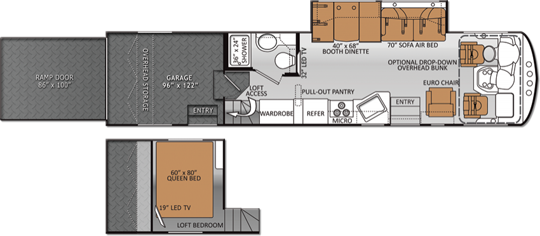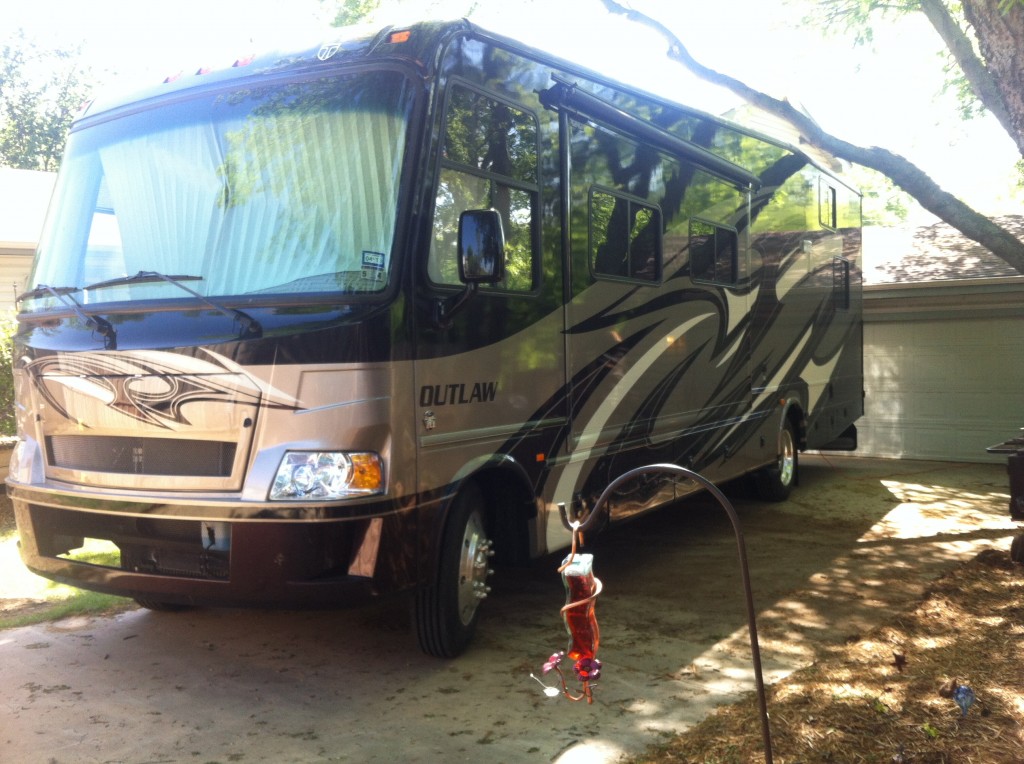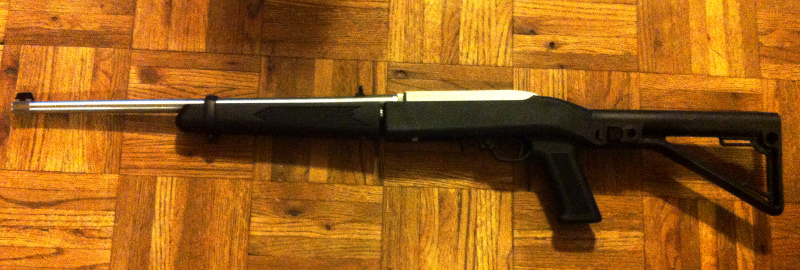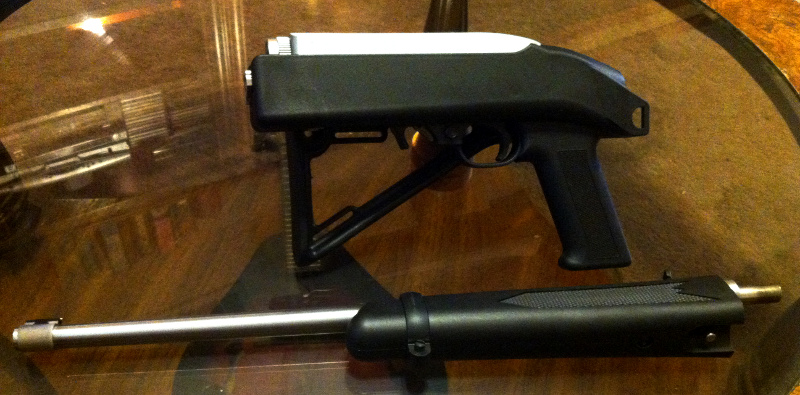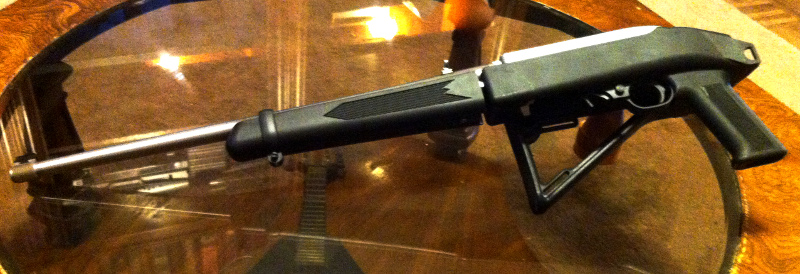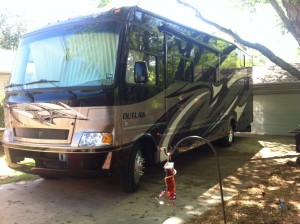
The Thor Outlaw Toy-Hauler Motorhome is not what most people envision when they think of a BOV (Bug-Out-Vehicle)
When most people think of a “Bug-out-vehicle” they envision some 4×4 with an enormous amount of modifications loaded to the gills with supplies and packed with Mom, Dad, two kids, and the dog. The idea of this is that, should the zombie apocalypse come, if the cities are no longer safe the BOV (bug-out-vehicle) will allow the family to escape to the countryside with their supplies and survival gear.
What they do once they get there is anybody’s guess.
I’m not here to rain on anybody’s parade, much less their fantasies of pulling back into the high mountains where they can regroup and go all “Wolverines” on some Sino-Russian invaders. The fact remains that such a scenario is so highly unlikely as to be all but impossible.
History may not repeat itself, but it does rhyme a little. In previous situations where there was a mass exodous of urban areas due to war or natural disaster, the survivors didn’t head for the hills and use their MREs and water purifiers to ride out the conflict. No, they headed to other civilized areas, perhaps where they had friends, family, or other contacts, and there they attempted to start life over.
During hurricane Katrina evacuees went to Baton Rouge, Houston, Dallas, and even far flung areas such as Seattle and Chicago. During the Battle of Mosul during the second invasion of Iraq, non-combatants didn’t hunker down in the desert. They fled to other nearby cities where the fighting was not as intense if it existed at all. The same thing happened in Fallujah. Even in late 1991 in Mogadishu everyone who had the ability and a desire to escape the fighting there fled to Ethiopia, Kenya, or parts of Somalia that remained untouched by the conflict. It is rare indeed to find a single historical example where people “head to the hills” to escape war or natural disasters.
Why then are preppers and survivalists so dead set on planning to escape to the countryside? Where indeed IS this mythical countryside? If you don’t have an actual redoubt of a few dozen acres at a minimum, where will you go? Hunters know just how fast public lands and wilderness can fill up during hunting season. Even private lands used for hunting or agriculture sit vacant for most of the year only to become virtually infested with people during hunting or planting/harvest season.
Imagine just a fraction of a nearby urban area flooding into that same area: you would not be able to turn around without tripping over another person or family seeking to escape the same thing you are. In some states such as Texes those large tracts of open wilderness simply don’t exist: it’s all privately owned and will in all likelihood be defended against trespassers and squatters.
I feel comfortable in saying that 99.9% of people in the United States will not seek out shelter under the open skies of the grasslands or tucked into some heavily-wooded mountainside. Unless they have a rural base of operations already set up, they will instead take to the highways and byways and travel until they reach urban areas that are not affected by whatever disaster they seek to escape.
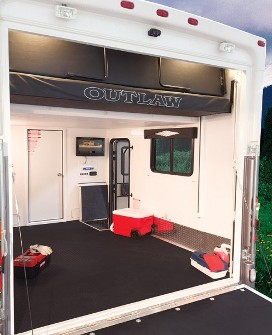
The garage is spacious, but not quite large enough to carry a wide variety of lightweight subcompact cars. While you can fit a number of motorcycles or an ATV/UTV with ease, the Smart FourTwo is the only modern production car available in the United States that is able to be squeezed inside.
That being the case, when I was offered the opportunity to review the Thor Outlaw I decided to evaluate it based on what I had in mind for a practical (if a bit over the top) bug out vehicle. How well does it work as a way to travel in relative luxury while not straying too far from civilization and all the utilities we’re accustomed to?
The Thor Outlaw has a lot going for it. It is a 37-foot long toy hauler motorhome designed for transporting a family and their smaller vehicles. It has a ton of room, an onboard generator, plenty of roof space open for the addition of solar panels, satellite transceivers, and other accessories, and a stout inverter/battery setup capable of running everything but the A/C units for 4-hours or more without needing to be recharged.
The generator itself is a high-end Onan model (which one varies depending on the options chosen) that feeds off of the same gas tank that fuels the engine. Generator noise is a genuine concern of those worried about OpSec. While not as quiet as the older diesel model generators available on older FRED (Front Engine Diesel) chassis, the Onan is still not so loud as to be obnoxious.
To prevent users from being stranded without gasoline however, it is designed to automatically cut off when the main fuel tank reaches 1/4 full. Fuel tank size varies with chassis options as well, but 75-gallons is standard. At an average load and fuel consumption rate of around 1/2-gallon per hour, and assuming a full tank of fuel, users can expect to be able to run the generator for as much as 100 hours.
That is, of course only if you’re not fueling up your other vehicles using the fill station located underneath the body. On the left side of the chassis in a lower locker behind the gen-set is a convenient fuel station for all of your gasoline-powered toys and vehicles. Like the generator, it also feeds off of the central fuel tank and shuts off automatically at 1/4 of a tank.
Our model was outfitted with 5 flat-screen televisions, but no satellite TV or internet: upgrades we’d like to make soon. The interior is well appointed with leather and wood trim throughout. The primary sleeping space is a small loft set above the garage. With only a 32″ clearance I was initially concerned that it would be difficult to get in and out of this sleeping area. As it turned out it wasn’t so bad, though I could see how the tight spiral stairs could be difficult for older folks.
This particular model Outlaw has a queen-sized bed that is able to be lowered in the garage to make that space into another bedroom, though there are no A/c vents plumbed to the area. This is easily remedied with a space heater in the winter, but we’ve yet to figure out an effective summer solution. Perhaps as temperatures warm we’ll figure something out.
Despite all of its wonderful amenities, the Thor Outlaw is not without its flaws.
Powered by a 362 horsepower Ford Triton V-10 engine, it lacks one of the primary things I look for in a vehicle such as this: diesel. Why diesel? Besides greater fuel efficiency, a diesel powerplant is truly necessary for a vehicle of this size. Driving the Thor Outlaw from the dealer to my house. a trip of less than 30 miles, it had to downshift a half dozen times just to make it up each overpass on the local urban freeway without losing too much speed. Bear in mind that we were driving this RV empty: no cargo, towing nothing, and with empty water tanks. In hilly terrain, much less summiting a mountain pass, it would be sorely taxed while empty, and I could not imagine trying to make it up a steel slope with the Outlaw loaded to capacity.
The garage measures just a hair over 120″ in useable length: more than enough to store an ATV or UTV, or as many as three motorcycles. But that size (and GAWR) makes all but the smallest cars unable to fit. Only the Smart FourTwo and the original Austin or Morris Mini (classics that are difficult to find in good condition and priced accordingly) are able to fit inside this space.
The axle loads (GAWR) and overall weight (GVWR) is something that you truly must pay attention to. It’s ridiculously easy to overload this motorhome. With almost 400 square-feet of interior space, it doesn’t take much to hit the mere 22,000-pounds the Ford chassis is rated for on this model. Other chassis/engine combinations are rated slightly higher, but it still takes a bit of planning to get the balance just right. With the bulk of the storage in the rear a responsible owner must pay very close attention to the weight over the rear axles. If you’re going to have any kind of vehicle in the garage, make sure that all of the rest of your heavy cargo is stored as far forward as possible.
The other drawback to the Outlaw is its size. Despite having a relatively low GVWR, it’s big. Really big. Which is what you’d expect from a Class A vehicle, because after all buyers of a motorhome this size want room to stretch out. Unlike traditional class A coaches, because the Outlaw also has a second-floor loft over the garage it is also very nearly too tall. At 12-feet 10-inches tall, you’ll have to keep a sharp eye out for low bridges, trees, and even power and utility lines. Most highway overpasses are 13-feet 6-inches at a minimum, but as you make your way to more rural areas your chances of finding your way barred by a low bridge increases.
Navigate the narrow roads through state parks or private campgrounds and you’ll usually see a plethora of trees, valued for their beauty and shade. Low hanging branches however will scratch up the side of this motorhome, and can even cause damage to roof mounted vents, antennas, and air conditioning units.
That may not be a problem during a zombie apocalypse, but until you’re dodging Zeds on the way to your retreat, it will seriously impact the overall appearance and value of this luxury RV.
The height of the Outlaw also makes it prone to sway. Crosswinds, or even gusts of air from oncoming traffic, can cause the vehicle to sway dangerously. I highly recommend upgrading to larger front and rear sway bars. These have proven to make a remarkable difference in the overall stability of the motorhome while driving.
“Boondocking” as it is called among RVers, where the motorhome or camper is setup with no outside services for power, sewer, or water, is not the Outlaw’s strong point. In this role it gets a solid “F” as a bug-out-vehicle in what many would consider the classical sense. Sure, it can be done, but with only a 30-gallon grey-water tank you won’t get much use out of all the including plumbing. A single shower alone would completely fill up the grey-water tank and nearly empty the 75-gallon fresh water tank. If one were conservative and recycled water from the sink (into the toilet for example) and limited showers to one very quick sponge-bath style cleaning every couple of days, it would be possible to live for as long as a week in relative comfort. I wouldn’t want to try it with a large family with kids however.
When it comes to camping without services and utilities, the Outlaw is best suited to short trips such as overnight and weekends. In this role it really starts to hit its stride. As a mobile home, complete with smaller ground transportation in the form of a micro-car or two to three motorcycles it excels.
Were I to find myself in a situation where evacuation was necessary with the Thor Outlaw as an escape option, I really wouldn’t think twice about loading up the Outlaw with the wife and pets and heading for an area where civilization still existed. With a range of just over 500 miles it’s possible to travel quite a ways before refueling is necessary.
Earlier I mentioned that the Outlaw is a luxury RV, because this particular model has an MSRP just shy of $150,000. In comparison to other coaches of comparable size however, it is just an entry-level model. Fully optioned motorhomes in this class can easily exceed $1,000,000 in price and still have no more overall functionality as a BOV. You’d have to stretch far up into the stratosphere to find purpose-built offroad RVs built by the likes of Unicat to find the functionality of what most consider the ideal BOV.
Will the Outlaw work as BOV?
Yes.
Fantasies of zombies and “Red Dawn” style invasions aside, the Outlaw is perfect for transporting you, your loved ones, and not a small amount of gear, including other vehicles, from an area beset by civil unrest, war, or natural disaster, to nearby areas where modern accoutrements can still be found. It will function perfectly in this manner while parked next to a place where it can be tethered to power and water.
In Texas, or anywhere along the U.S. gulf coast, hurricanes are the most common reason for mass evacuations. Were another Katrina to hit this would be the perfect way to bug out. Sure, gas lines may be long, but you’ve got a 500 mile range and room enough to carry additional fuel in the garage should it be necessary.
If “bugging out” to you means you still want to maintain the standard of living to which you’re accustomed, a large toy hauler motorhome like the Outlaw may be just what you’re looking for.

